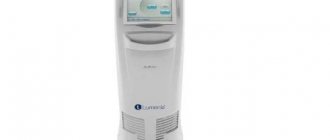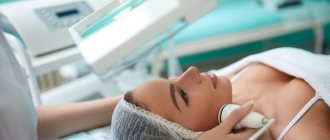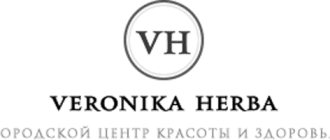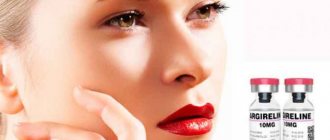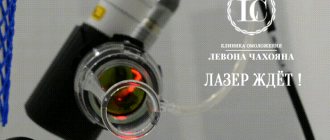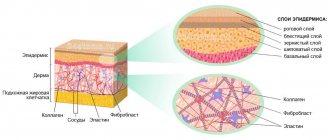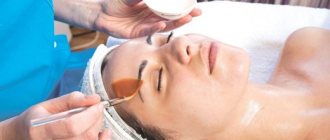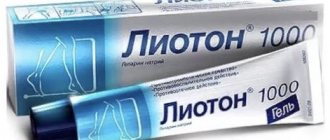Pigmentation after laser pigmentation removal is a fairly common problem. Usually, laser therapy is performed by a specially trained specialist who works only with the device, and the problem of pigmentation after the laser has to be solved by a cosmetologist.
Why it occurs and how to avoid it in the article below.
To understand why age spots appear after laser removal, you need to understand what happens in the skin in response to laser exposure.
Rehabilitation after Fraxel
Proper rehabilitation after Fraxel will help you go through the recovery period easily and comfortably. The basic rule is not to expose your skin to ultraviolet radiation. When outdoors, use sunscreen with a high SPF (at least 30). There is no need to go to the solarium or sunbathe for a month after Fraxel. If you follow this rule, you can carry out the procedure at any time of the year and with any skin phototype.
To reduce discomfort, in the first days after Fraxel laser photorejuvenation, moisturizing and nourishing products should be applied to the skin after the procedure. You can treat your skin with Panthenol. You need to say a decisive “no” to mechanical peels and scrubs for a couple of weeks, but you can use decorative products literally the next day.
The length of the recovery period depends on the type of procedure. After Fraxel re:store DUAL and Fraxel re:fine, the skin is restored in a couple of days, and during this period there is no need to hide from prying eyes. After Fraxel re:pair, you may have to stay at home for 3-4 days, but by the sixth day the peeling and redness goes away.
Remember, the body’s reaction to the procedure is always individual. You can learn more about recovery after Fraxel fractional laser and receive an individual rejuvenation program during a consultation with a cosmetologist at the Soho Clinic.
Rehabilitation period
- Cosmetologists advise doing laser resurfacing during the holidays in order to leave the house as little as possible. After the procedure, the skin is sensitive to UV rays, high and low temperatures, and susceptible to infections. What needs to be done during the recovery period of the skin?
- Apply a cold compress to the face for no more than 5 minutes.
- Apply a cream with an antiseptic and antibiotic: “Panthenol”, “Elocon”.
- Use gels to moisturize.
- Maintain drinking regime.
After laser resurfacing, it is not recommended to touch your face or wash your face. During skin rehabilitation, use as little decorative cosmetics as possible. When leaving the room, apply sunscreen to your face. It is not recommended to remove peeling areas of skin. They should detach on their own. Otherwise, young skin can be damaged. Rehabilitation lasts up to 7-8 months. Rejuvenating effect – 5-7 years.
How to prepare for a laser procedure
The general rule that applies to laser treatments is to avoid tanning before the procedure. Patients should avoid going to the beach and solarium for at least four weeks before the session.
A laser beam, like sunlight, is light energy. Therefore, the combination of tanning and laser will overload the skin, which can lead to inflammation, irritation, prolongation of the recovery period and progression of the aging process.
The presence of a large amount of melanin pigment in the skin, which appears during tanning, can reduce the effectiveness of the laser and lead to the appearance of dark or light spots formed due to pigmentation disorders.
Pigmentation disorder
GENERAL RECOMMENDATIONS
Two weeks later, after the formation of a new surface layer of skin, provided that there are no side effects such as redness, burning or itching, you can carefully proceed to normal facial skin care. At this time, it is not recommended to use new, untested products to avoid allergic rashes. Also, keep in mind that renewed skin is still very sensitive to sunlight. Therefore, to avoid hyperpigmentation, use special sunscreens with a high degree of protection (3 months). There should be no painful sensations: if they occur, consult a doctor immediately.
Laser resurfacing is an effective weapon in the fight for beautiful skin.
Skin resurfacing (dermabrasion) is a deep peeling procedure during which the epidermis and part of the dermis are completely removed. One of the progressive methods of skin resurfacing is to carry out this procedure using a laser. In this case, its radiation leads to complete evaporation and coagulation of soft tissue to the required depth. The main difference between laser skin resurfacing and laser peeling is the depth of the surface effect of this procedure - with laser peeling it does not exceed 30 microns, while with laser resurfacing it reaches 150 microns (corresponding to the depth of the basement membrane). Thus, it is possible to effectively even out the relief of the skin, remove deep wrinkles and scars.
There are the following types of laser resurfacing:
- Carbon dioxide laser (CO2). The use of this laser provides maximum effect from the procedure, but also more opportunities for complications, as well as a long rehabilitation period.
- Erbium laser has a more gentle effect on the skin. There is less chance of complications and a shorter rehabilitation period.
Traditional laser skin resurfacing involves completely removing layers of skin to a certain depth. At the same time, it is characterized by high trauma and a long recovery period, as well as many complications. More gentle, but no less effective, is fractional laser resurfacing, in which the epidermis is removed not from the entire surface of the skin, but from its individual fragments. As a result, the formation of an extensive wound surface is prevented, and the presence of intact skin between the damaged micro-areas leads to rapid healing and a reduction in complications.
Fractional laser resurfacing involves the use of carbon dioxide or erbium lasers. The first leads to significant heating of the surrounding tissue areas being treated, which increases the risk of burns and increases the healing period. Resurfacing of the eyelid and neck areas with this laser should be done with great care. The carbon dioxide laser is an excellent tool for removing skin tumors and resurfacing stretch marks and scars.
A more advanced tool for skin resurfacing is the erbium laser. Its radiation is divided into several micro-rays, which, when exposed to the skin, create tiny depressions in it. In this case, undamaged areas of the skin after the procedure are tightened over the damaged ones, which provides a pronounced lifting effect. In this case, the procedure is painless and there is no risk of side effects. In addition, the soft effect of the erbium laser allows it to be used on delicate areas - eyelids and neck.
Heating of the skin occurs due to its absorption of photons of laser radiation. To adjust the depth of exposure, change the laser power or the duration of its radiation pulses. Heating the skin causes the water contained in it to evaporate, vaporization, and cell destruction. Throughout the depth of the microthermal zone, tissue coagulation occurs, protein, old collagen and elastin are destroyed. The presence of healthy cells around damaged areas ensures their rapid regeneration.
Laser resurfacing is effective against photoaging of the skin, which is caused by exposure to ultraviolet radiation on the skin. As a result, wrinkles appear and the elasticity of the skin decreases due to an increase in its thickness, accumulation of fibrous tissue and a decrease in the amount of interstitial fluid. This procedure also helps in getting rid of scars that form due to injuries, burns, improper healing of wound edges, prolonged regeneration and the skin’s tendency to keloid scars. In this case, the connective tissue penetrates the intercellular space, forming a new layer, which leads to the formation of scars. The effect of laser radiation on connective tissue leads to its destruction and stimulation of the division of neighboring cells. Other indications for laser resurfacing include enlarged pores, pigment formations, stretch marks and age-related changes.
Laser resurfacing of facial skin is carried out for the purpose of:
- Rejuvenation;
- Removal of scars, scars and age spots;
- Removal of stretch marks (stretch marks);
- Correction of the consequences of acne - post-acne;
Contraindications to laser resurfacing
Laser resurfacing can be performed at any age. Some restrictions on it are imposed by the presence of allergies, poor healing of scars, dark skin, etc. People with dark skin tones need to treat it with bleaching agents before the procedure to reduce the risk of dark pigmentation during healing. They should also undergo whitening after laser resurfacing. Laser resurfacing is not recommended during pregnancy, lactation, immunodeficiency, exacerbation of chronic somatic diseases, recurrent acne, cancer, psoriasis, epilepsy, and should also be carried out with caution if there is a tendency to form keloid scars. Also, before starting the procedure, you should wait at least three months after the last time you took retinoids. Preparing for the procedure. When carrying out the procedure on large areas of the skin, general and biochemical blood tests, detection of antibodies to hepatitis B, C and HIV, and blood microreaction are performed as pre-procedure tests. To suppress the activity of pigment-forming structures of the skin, it is recommended to perform a superficial chemical peel before laser resurfacing.
Carrying out the laser resurfacing procedure
Immediately before the procedure, anesthesia is performed - local or general (anesthesia), depending on the area and depth of exposure. It can be superficial (using anesthetic creams) or intravenous, which can reduce the feeling of discomfort during the procedure by reducing skin sensitivity. And also before the procedure, the doctor removes facial makeup, wipes the treatment area with an antiseptic and puts protective glasses on the patient’s eyes if the face is being treated.
The doctor performs initial treatment with a laser beam, removing the surface layer of the epidermis. After treatment, the skin becomes whitish in color. This indicates that the laser beam has passed through the epidermis to the basement membrane. If local anesthesia was used, the doctor reapplies the anesthetic cream. After 5-10 minutes the procedure can be repeated.
The procedure lasts until the damaged areas of the skin are removed or until droplets of blood appear on the surface of the skin, which indicates that the laser beam has reached the papillary or papillary layer of the dermis, located under the basement membrane and containing a large number of tiny blood vessels and capillaries. The maximum therapeutic effect with minimal risk of complications is achieved at this level.
Duration and number of procedures
The duration of one laser resurfacing procedure can reach 2 hours (when treating the entire surface of the face). For partial facial treatment, the session duration does not exceed 45 minutes; if the procedure is performed on the body, the time depends on the area of the surface being treated. This time also depends on the patient’s skin type, its current condition, individual characteristics of the body, age and other factors that must be taken into account by the doctor.
Skin care after laser resurfacing
After laser resurfacing, the skin is in a condition similar to that of a second-degree thermal burn. The surface of the skin is an open wound with exudate flowing out. Treated skin should not be touched or combed. On the second or third day after the procedure, crusts form on the surface of the skin, which begin to come off on days 5-7. The crusts cannot be removed independently; reddish spots form at the site of their origin, which disappear within 3-6 months. The rehabilitation period takes 2-3 months. If fractional laser resurfacing was carried out, the rehabilitation period lasts much less - about two weeks.
Immediately after laser resurfacing, the treated skin areas are covered with a sterile bandage, which is removed after 1 to 3 days (depending on the degree of exposure). The skin is in a condition similar to a 2nd degree burn and requires careful care. It is necessary to treat the affected areas of the skin up to 5 times a day with antibacterial, anti-burn, moisturizing and wound-healing preparations (Olazol, Argosulfan, Bepanten-plus, Pantesol, Linetol, Vinizol, Levovinisol, Lifuzol, Solcoseryl, Levomekol, Natursil, Radevit, sea buckthorn, peach oils and wheat germ oil). You can wash your face with sterile thermal water from a spray bottle. If pain bothers you greatly, you can take painkillers (Ketanov, Nurofen Express). Please note that you cannot mechanically remove formed crusts; removing them yourself can lead to the formation of foci of hyperpigmentation. It is also necessary to treat skin that has undergone laser resurfacing with a cold vinegar or saline aqueous solution. The duration of such care is up to 3 weeks (depending on the condition of the skin). Areas of skin that have undergone laser resurfacing must be protected from ultraviolet rays until their natural color is completely restored, which may take up to one year. During the first 2 months, it is recommended to use sunscreen with an SPF of at least 35. Therefore, it makes sense to carry out this procedure in late autumn or early winter, when the intensity of solar radiation is minimal.
Within 2 - 3 months (with strong exposure up to 6 months) after the procedure, red or pink areas may be noticeable on the surface of the skin. To disguise them, you should use non-greasy green shades of makeup, since it is this that effectively neutralizes the red color. It should be borne in mind that the disappearance of redness in people with red or blond hair occurs over a longer period of time.
Possible complications after laser resurfacing
Immediately after the procedure, the patient feels like a sunburn - for 12 to 72 hours he is bothered by itching and burning. Therefore, anti-burn medications should be used. The main complications of laser resurfacing include small whiteheads (milia), hyper- and hypopigmentation, recurrent cold sores, bacterial infection, swelling and scars. To get rid of milia, gentle cleansing with terry cloths is recommended. Hyperpigmentation usually resolves over time and can be reduced by applying a whitening cream. Repeated herpetic fever most often occurs during laser resurfacing of areas near the mouth. To prevent it (as well as any other bacterial infection), you should take an antiviral drug before the procedure and for 7-10 days and after it, as well as antibacterial drugs after the procedure, orally and locally. If swelling occurs, it is recommended to use an additional pillow for sleeping, and apply ice to the treated areas in the first 24 to 48 hours after the procedure. Scars may occur with deeper exposure to the laser beam or if the skin tends to form keloid scars. A “gauze effect” may occur from the impact of a fractional laser if the parameters are set incorrectly. Areas of hypopigmentation resulting from the death of melanocytes may remain forever. Mandatory use of sunscreen. It is recommended to stop smoking during the rehabilitation period, as it has a negative impact on recovery. 5–7 days after laser resurfacing, the skin becomes dry and begins to peel. To eliminate this effect, light scrubs and moisturizers are used. The duration of the recovery period, after which you can start working, does not exceed 2 weeks. Full physical activity is allowed after 4 – 6 weeks.
The effect of laser resurfacing
The primary effect of laser resurfacing becomes noticeable a week after the first procedure - small defects, wrinkles and crow's feet around the eyes will disappear, pores will narrow, the skin will tighten, its texture and tone will become even, large defects will noticeably decrease in size and depth, and their edges will will be smoothed out. Moreover, these effects are progressive and their final results can be assessed after 3-6 months - the skin is noticeably rejuvenated (becomes even and smooth), collagen is renewed, the oval of the face is tightened, and the consequences of gravitational ptosis are eliminated. The effect of laser resurfacing of facial skin for the purpose of rejuvenation can last for several years, and if you removed scars or stretch marks, the result will be permanent.
Laser resurfacing. Before and 4 weeks after the procedure. The patient is 39 years old
Laser resurfacing. Before and 4 weeks after the procedure. The patient is 55 years old
Laser resurfacing. Before and 4 weeks after (three procedures). The patient is 46 years old
Natalia Komarnitskaya
Burns and blisters
Negative consequences - blisters - occur if the laser power was selected incorrectly, the skin was not cooled sufficiently, or the recommendations were violated.
Before the procedure, the patient should not use decorative cosmetics; they can cause a burn with blisters.
If blisters appear on the face after removing blood vessels with a laser, this indicates excessive intensity of radiation energy.
Treatment for burns of this nature is as follows:
- The damaged area is cooled;
- Bubbles and blisters do not open after laser removal of blood vessels;
- If the bladder wall is damaged, treatment is carried out with an antiseptic drug;
- If the bladder is not damaged, hormonal ointment and panthenol are applied 3-4 times a day. Hormonal ointment for no more than 5-7 days, then only panthenol.
- If the bubble is injured and liquid comes out, a crust forms at this place, which is strictly forbidden to be torn off! Otherwise there will be a scar or pigmentation.
What is laser resurfacing?
Laser resurfacing is a gentle vaporization (dehydration) of dead skin cells in problem areas, which triggers accelerated collagen synthesis and other regeneration processes.
Cosmetologists recommend this procedure for the following problems:
- decreased skin elasticity and other age-related changes;
- photoaging associated with prolonged exposure to the sun;
- pigmentation;
- uneven facial contour;
- dull skin color;
- fine wrinkles, which over time can turn into deep ones;
- stretch marks on the body;
- scars and scars.
All these problems can be prevented and their progression can be significantly slowed down with the help of laser resurfacing, after which the skin becomes smoother and more youthful, and a pronounced lifting effect is observed.
Laser resurfacing is rightfully considered the safest and most effective method of rejuvenation, being, in fact, a real alternative to plastic surgery.
What to do on the day of the laser procedure
Make-up and skin care products should not be on the skin, as they can interfere. The cosmetologist additionally cleans the procedure site with special means to remove obstacles in the path of the laser beam.
After preparation, a specialist uses a special attachment to apply a laser to the face. Depending on the type of procedure, the impact can be deep or superficial. As a rule, the more serious the existing problems, the deeper the laser must be applied.
Effect of laser on skin
The procedure does not cause pain, since during deep exposure an anesthetic gel is applied to the treated surface. Only the heat, touch and light flashes of the laser can be felt.
Laser procedures do not require a stay in the clinic, so after completion you can go straight home.
